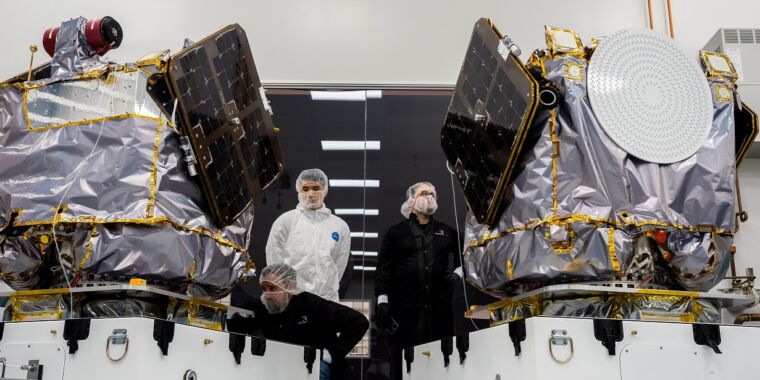Two NASA spacecraft built by Rocket Lab are on the road from California to Florida this weekend to begin preparations for launch on Blue Origin’s first New Glenn rocket.
These two science probes must launch between late September and mid-October to take advantage of a planetary alignment between Earth and Mars that only happens once every 26 months. NASA tapped Blue Origin, Jeff Bezos’ space company, to launch the Escape and Plasma Acceleration and Dynamics Explorers (ESCAPADE) mission with a $20 million contract.
Last November, the space agency confirmed the $79 million ESCAPADE mission will launch on the inaugural flight of Blue Origin’s New Glenn rocket. With this piece of information, the opaque schedule for Blue Origin’s long-delayed first New Glenn mission suddenly became more clear.
The launch period opens on September 29. The two identical Mars-bound spacecraft for the ESCAPADE mission, nicknamed Blue and Gold, are now complete. Rocket Lab announced Friday that its manufacturing team packed the satellites and shipped them from their factory in Long Beach, California. Over the weekend, they arrived at a clean room facility just outside the gates of NASA’s Kennedy Space Center in Florida, where technicians will perform final checkups and load hydrazine fuel into both spacecraft, each a little more than a half-ton in mass.
Then, if Blue Origin is ready, ground teams will connect the ESCAPADE spacecraft with the New Glenn’s launch adapter, encapsulate the probes inside the payload fairing, and mount them on top of the rocket.
“There’s a whole bunch of checking and tests to make sure everything’s OK, and then we move into fueling, and then we integrate with the launch vehicle. So it’s a big milestone,” said Rob Lillis, the mission’s lead scientist from the University of California Berkeley’s Space Science Laboratory. “There have been some challenges along the way. This wasn’t easy to make happen on this schedule and for this cost. So we’re very happy to be where we are.”
Racing to the finish line
But there’s a lot for Blue Origin to accomplish in the next couple of months if the New Glenn rocket is going to be ready to send the ESCAPADE mission toward Mars in this year’s launch period. Blue Origin has not fully exercised a New Glenn rocket during a launch countdown, hasn’t pumped a full load of cryogenic propellants into the launch vehicle, and hasn’t test-fired a full complement of first stage or second stage engines.
These activities typically take place months before the first launch of a large new orbital-class rocket. For comparison, SpaceX test-fired its first fully assembled Falcon 9 rocket on the launch pad about three months before its first flight in 2010. United Launch Alliance completed a hot-fire test of its new Vulcan rocket on the launch pad last year, about seven months before its inaugural flight.
However, Blue Origin is making visible progress toward the first flight of New Glenn, after years of speculation and few outward signs of advancement. Earlier this year, the company raised a full-scale, 320-foot-tall (98-meter) New Glenn rocket on its launch pad at Cape Canaveral Space Force Station and loaded it with liquid nitrogen, a cryogenic substitute for the methane and liquid hydrogen fuel it will burn in flight.











